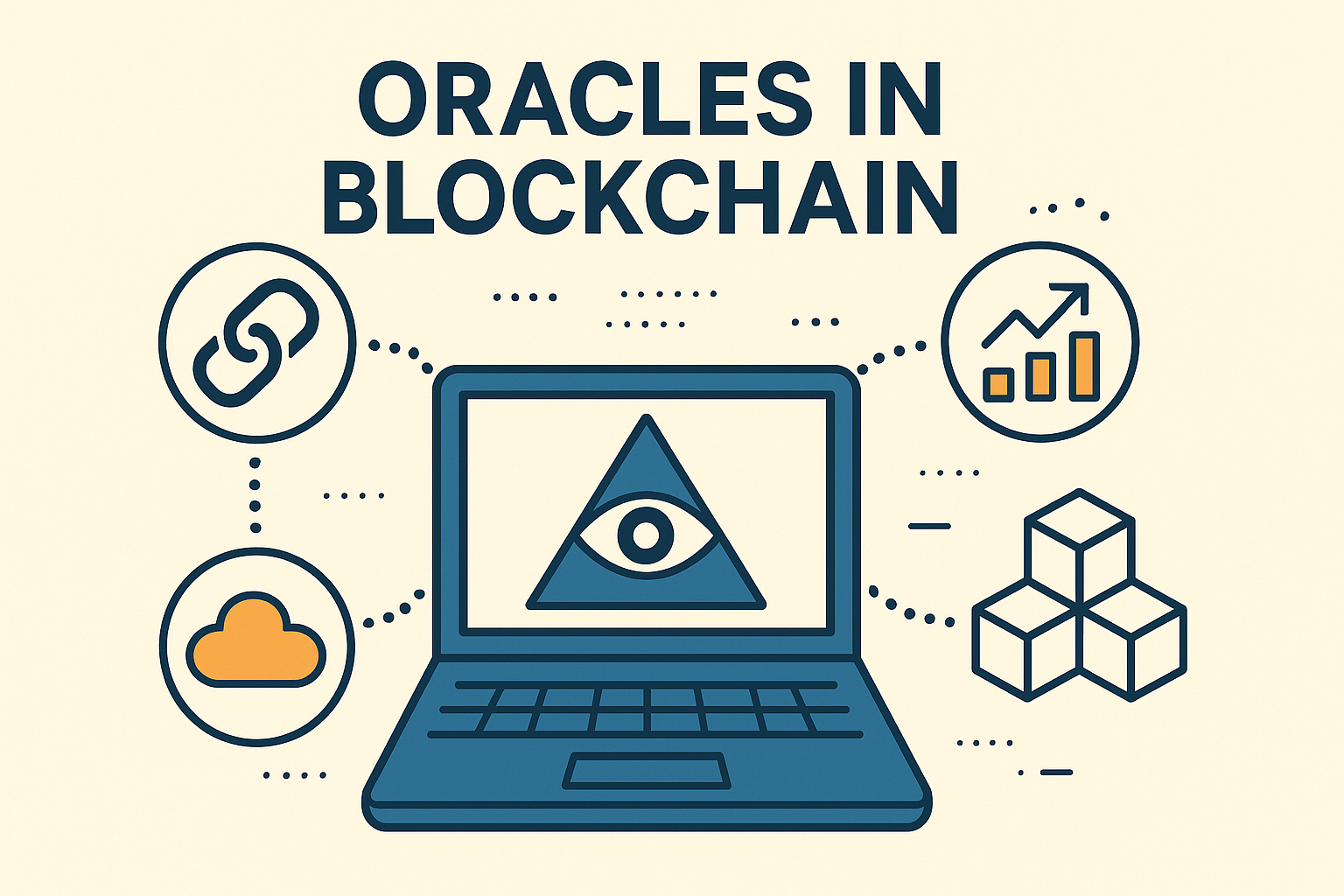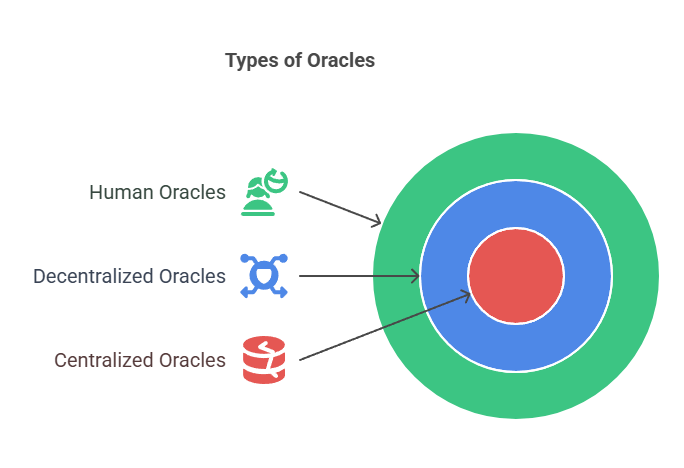In this article, we learn what Oracles in blockchain is, Types of Oracles and how they work in blockchain.
Oracles
Oracles serve as links between the blockchain and the outside world in the context of blockchain, supplying external data that smart contracts might use to operate in response to external circumstances. Smart contracts may access real-time data and carry out transactions based on external factors to their facilitation of the flow of information from external systems, such as APIs, IoT devices, and other data.

Oracles are crucial elements that solve a basic drawback of blockchain technology and smart contracts: the incapacity of smart contracts to directly access data from the external environment. Because blockchains are closed systems by design, smart contracts are deterministic and limited to using data that is stored on the blockchain. This leads to the “oracle problem”: how can a smart contract carry out reasoning based on data that isn’t on the chain or on actual occurrences?
An Oracle service serves as a data conduit between a blockchain smart contract and external data like web resources (APIs and URLs). They serve as an interface via which smart contracts get data from the outside. Oracles must supply this data impartially and reliably since smart contracts require volatile or real-world information to carry out transactions. Examples of such information include the price of stocks, the exchange rate for financial contracts, the temperature, or whether a shipment of real-world goods has occurred.
This is a more thorough explanation:
What they do:
Oracles retrieve information from outside and send it to blockchain smart contracts. Sports scores, market prices, weather, and even data from Internet of Things devices can all be included in this data.
Why they’re needed:
Because smart contracts are deterministic and self-executing, they must rely on data that is already stored on the blockchain. Their powers are increased by Oracles, which provide them access to external data and enable them to operate in real-world circumstances.
How they work:
Oracles can be implemented in a number of ways, such as hardware oracles that access physical sensors or software oracles that retrieve data from digital.
Types of Oracles:

Oracles come in a variety of forms, such as:
- A single point of failure could result from centralized oracles, which are run by a single organisation.
- Decentralized Oracles: Dispersed among several organisations, providing increased security and resilience.
- Human Oracles: These depend on people to collect and validate data, necessitating reliable outside.
Oracle Problem:
The “oracle problem,” or the possibility that hostile or flawed oracles will give smart contracts erroneous data, is one of the main issues with oracles. Financial losses and unforeseen repercussions may result from this.
Oracles are generally regarded as reliable organisations that use a safe conduit to move off-chain data to a smart contract.
You can also read Blockchain Trust Layer: How Decentralization Create Security
How oracles work
There are multiple processes involved in the basic mechanics of how oracles typically operate:
- An oracle receives a request for particular data from a smart contract.
- The request is carried out by the oracle, which retrieves the necessary information from an outside. These can range from databases (such as enterprise legacy systems) to web services, APIs, or even another blockchain.
- To attest to the data’s legitimacy or authenticity, the retrieved data is frequently transmitted to a notary or a system that creates cryptographic proof, usually a digital signature. For this, methods such as trusted hardware-assisted proofs, Android proofs, Ledger proofs, and TLSNotary can be employed.
- The information is returned to the oracle with its validation.
- Before being made available to the smart contract for verification, this data and proof may optionally be kept on decentralised storage systems such as Swarm or IPFS, particularly if the proofs are substantial. A callback function is frequently used to return the desired data to the smart contract.
Oracles resolve the issue of linking smart contracts to outside data, but they also create a conflict of trust known as the Blockchain oracle dilemma. Relying on a third-party oracle to supply data reintroduces a point of centralisation and possible vulnerability because smart contracts are trustless. The execution of a smart contract could be triggered by a malicious or flawed oracle feed, which could have unforeseen effects, such as the irreversible loss of cash. The accuracy of the data itself isn’t always assured, even with attestation methods.
You can also read Blockchain Hashing Explained: Core Of Security And Integrity
Different kinds of oracles and solutions have surfaced to address the “oracle problem” and lessen this trust issue:
- Inbound Oracles: Provide the smart contract with data from outside.
- Software Oracles: Get data from the web (travel, financial information, weather).
- Hardware oracles: Gather information from tangible objects, such as Internet of Things sensors. These call for cryptographic verification and tamper-proof techniques.
- Computation Oracles: Give smart contracts the ability to ask for and obtain validated results from intricate off-chain calculations. One example is Truebit.
- Aggregation-Based Oracles: Utilise techniques like averaging or taking a median to a single value from several feeds to lessen dependency on a single. Such a price feed oracle is used by MakerDAO.
- Crowd Wisdom-Driven Oracles: Combine information from various users or the public to determine the most likely result. This tackles the problem of depending solely on one, perhaps unreliable.
- Decentralized Oracles: Developed to do away with dependence on a single, reliable third party, these systems are frequently based on distributed processes or use data from other blockchains that use consensus. Augur is mentioned as an excellent illustration.
- Smart Oracles: These, which were suggested by Ripple Labs (Codius), also have the capacity to run contract code.
- Send information from the blockchain to the outside world using outbound or reverse oracles. These might be triggering events on external hardware or legacy systems, or they could be blockchain measurements.
Oracle-as-a-service platforms are a group of internet platforms and services that offer Oracle functionality. The Realitio project, Town Crier, Provable, Witnet, Chainlink, TrueBit, iExec, and smartcontract.com are a few examples. These services are designed to assist smart contracts in safely obtaining the off-chain information required to make choices.
Oracle-supporting technologies include frameworks like Avalon that provide hardware-attested oracles and safe off-chain processing, Intel SGX for trusted execution environments, and TLSNotary for authenticity proofs. Oracle services help connect the ledger to the outside world in Corda by supplying information that influences the authenticity of transactions. Oracles are another way that Hyperledger Fabric can communicate with external APIs.
For blockchain systems that need to communicate with real-world data, oracles are consequently essential bridges. However, the trust and security issues they provide must be carefully taken into account during the design and implementation process.
You can also read Types Of Blockchain Wallets: Hot, Cold, Hardware And More
